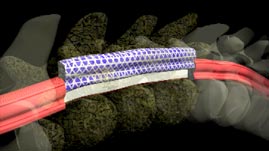Despite enormous strides in medical technology in the last several decades, dozens of diseases and other medical conditions remain incurable. Severe spinal cord injuries cause lifelong paralysis because doctors have not yet found a way to repair delicate nerve tissue. Medical researchers have also been unable to find a cure for Tay-Sachs, even though they know the cause of this devastating disease, which claims the lives of most of its victims before they reach the age of six. The list goes on: Diseases like diabetes, multiple sclerosis, Alzheimer's, and Parkinson's remain incurable, despite tireless searches for cures.
Unfortunately, understanding the cause of a disease and being able to cure it are two different things, especially when the disease originates from within the cell. Damaged or malfunctioning cells cause disease in a variety of ways: They may produce too much of one kind of protein, as seems to be the case in patients with Alzheimer's; they may produce too little or none of some other essential protein, as in cases of diabetes and Tay-Sachs; or the cells may stop functioning altogether.
One solution to these cellular dysfunctions may be to replace problem cells with healthy ones. That solution, however, presents huge problems of its own. Where will these healthy cells come from, and how can doctors get them to integrate into the patient's body so that the cells work properly? Organ transplants work for a small number of diseases. But doctors can't replace a patient's diseased brain or severed spinal cord. To treat these and many other conditions by swapping dysfunctional cells with healthy ones will require healthy cells that, in a sense, "know what to do" -- cells that have an inherent ability to become the type of cells the patient needs and to integrate in the patient's body just where they're needed.
Many experts believe that stem cells have this potential. These cells, which all of us have in our bodies, have the ability to develop into many different types of cells. Unfortunately, adults appear to have very few of the most versatile type of stem cell. Pluripotent stem cells can develop into any of the 200 types of cells that make up the human body. They are completely unspecialized -- a blank slate -- and they have the ability to replicate, or reproduce, indefinitely.
While pluripotent cells are few or absent in adults, they are relatively plentiful in embryos. Approximately four days after fertilization, an embryo's rapidly dividing cells create a hollow sphere called a blastocyst with a small cluster of pluripotent stem cells inside called the inner cell mass. To establish a colony of these cells, called a stem cell line, researchers collect some of these cells and grow them in culture. This colony of unspecialized stem cells can then be maintained indefinitely and serve as a source for further research and perhaps medical therapies in the future. By 2002, U.S. scientists had established about 60 such stem cell lines.
Unfortunately, cells from the inner cell mass cannot be collected without destroying the embryo. For many people, this use of several-day-old embryos -- albeit embryos that have been discarded from fertility clinics -- crosses moral and ethical boundaries. In response, many researchers are looking for other sources of pluripotent stem cells. Some are exploring ways to trigger more specialized stem cells (taken from adults) to, in a sense, regress and become more like pluripotent embryonic stem cells.

 Loading Standards
Loading Standards Teachers' Domain is proud to be a Pathways portal to the National Science Digital Library.
Teachers' Domain is proud to be a Pathways portal to the National Science Digital Library.
